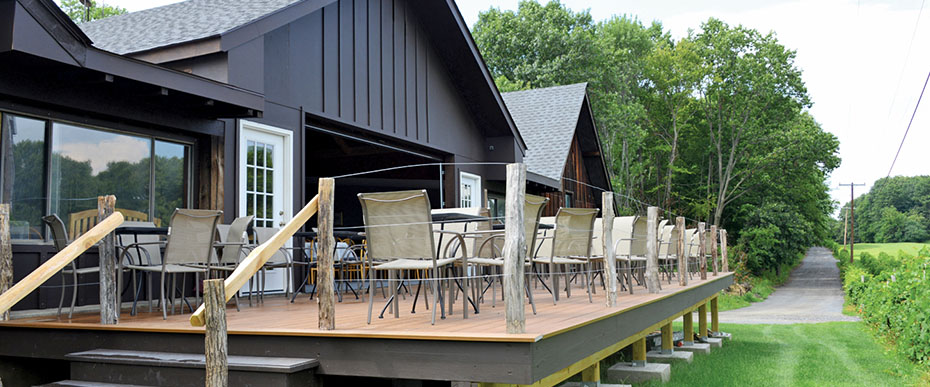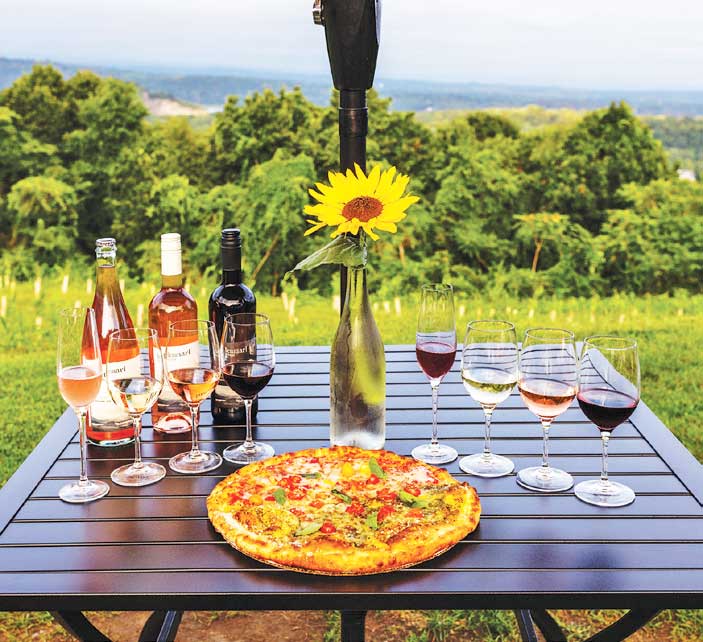Benmarl Winery
845.236.4265
Visit the website

Wine has been made from the grapes of the Hudson Valley since the 17th century when the French Huguenots grew vines and made wine in New Paltz. Among the young farmers attracted to this burgeoning industry in the early 1800s was Andrew Jackson Caywood, who bought and planted a handsome piece of land high above the river in a grape growing community that had begun in 1772. When the community incorporated as the Village of Marlborough, in 1788, a cluster of grapes carved in its seal commemorated its major crop. Caywood became an outstanding viticulturist and leading authority in the development of new grape varieties.
When the Miller family bought the Caywood property in 1957 and renamed it Benmarl, it had outlived all of its early contemporaries to become America’s oldest professional vineyard. The Millers rebuilt its steep terraces, replanting them with European wine grapes, both hybrid and vinifera, carrying on Caywood’s private experimentation at a time when New York’s wine industry was at a low ebb.
Savor This
Benmarl Winery was awarded “Hudson Valley Winery of the Year” at the Hudson Valley Wine & Spirits Competition – two years in a row! A distinguished judging panel awards this honor to the winery whose wines received the highest average score.
In 2006, the Spaccarelli family purchased Benmarl Winery from the Miller family, with the intention of reviving the spirit of Hudson Valley viticulture and the process of wine making. By replanting many of the abandoned vineyards and refurbishing the estate, they have managed to bring a new light to Benmarl, without sacrificing the tradition and history that makes it so special. Along with new plantings of Cabernet Franc, they are pushing the envelope with plantings of Blaufrankish, Saperavi, and Muscat Ottonel.
Benmarl and the Spaccarelli family are dedicated to the renaissance of New York’s first vineyard region. They strive to produce high-quality wines that are enhanced by the regional character which sets them apart from any others in the world.
IN THE SPOTLIGHT

2024 Dry Rosé
This dry, pale pink blend of 100% Cabernet Franc has become a staple at Benmarl over the past few years. Balanced, approachable, and extremely food-friendly, this wine is a perfect fit for a multitude of culinary endeavors.
2022 Cabernet Franc
Earthy with notes of raspberry and cherry. Lightly oaked with a spicy finish of black pepper and vanilla.
2021 Proprietor Reserve
This dry red blend of 80% Merlot, 13% Malbec and 7% Cabernet Franc is Benmarl’s richest red wine. Notes of red plum and blackberry, tobacco and dark chocolate.
DIRECTIONS
Hours
JAN–MAR
Daily: 11am–6pm
APR–OCT
Sun–Thurs: 11am–6pm
Fri–Sat: 11am–8pm
NOV–DEC
Daily: 11am–6pm
CLOSED
New Year’s Day, Easter, Thanksgiving, Christmas Day
Staff Picks
WHITE
- 2023 Stainless Steel Chardonnay
- 2023 Semi Dry Riesling
- 2024 Seyval Blanc
ROSÉ
- 2024 Dry Rosé
- 2024 Pétillant
RED
- 2022 Cabernet Franc
- 2021 Proprietors Reserve
- 2022 Malbec
- 2022 Estate Cabernet Franc
MEET THE WINEMAKER

Matthew Spaccarelli
At Benmarl Winery, the winemaking process has been increasingly focused on the idea of expressing the exceptional historic terroir that the winery sits on. “The decisions that we make in the cellar are very important,” says Matthew Spaccarelli, the winemaker of Benmarl. “But not as important as the quality and consistency of the fruit that we grow and purchase.”
The Spaccarelli family has also been looking to the future by refurbishing their existing vineyards and planting new ones. Investment in new temperature-controlled tanks, French and American barrels, and a state-of-the-art bottling line, has added to their focus on quality and consistency. But the changing climate offers a new set of challenges for winemakers in the Hudson Valley, as well as a responsibility to produce wines in a more sustainable manner. “The decisions that we make today will inevitably shape the environment we will have to work in down the road,” says Spaccarelli.
